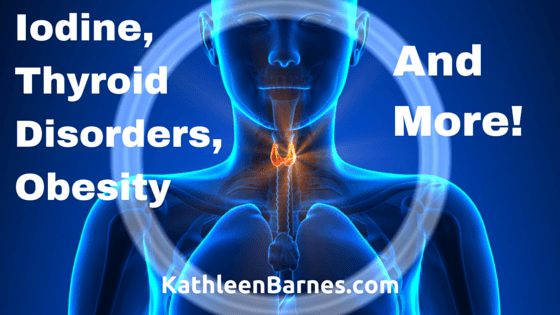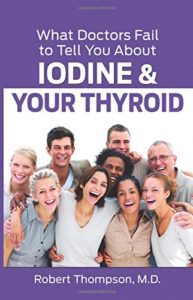Note from Kathleen: This is an excerpt from What Doctors Fail to Tell You About Iodine and Your Thyroid by Dr. Robert Thompson.
The thyroid is the body’s major thermostat and keeping it operating well keeps your metabolism running at the perfect pace.
Every single cell in your body depends on the thyroid gland for hormones that instruct it how to function.
This tiny butterfly-shaped gland at the base of your throat weighs less than an ounce and secretes less than a teaspoon of thyroid hormones in an entire year, but when things go wrong with your thyroid, they go wrong everywhere in your body.
The thyroid hormones regulate metabolism, the rate at which your body converts fuel (food) into the energy you need to power everything you do, the rate at which your body uses fats and carbohydrates, controls your body temperature, heart rate, the production of protein and your body’s ability to regulate the amount of calcium in your blood.
Too little, too much, just enough . . .
Too little thyroid hormone causes a disease called hypothyroidism, in simple terms, low thyroid function. In this most common of thyroid disorders, you are like a wind-up toy that is slowly winding down.
Too much thyroid hormone and the hormones flood your system, causing you to be hyper and frenzied, a condition called hyperthyroidism.
Autoimmune thyroid diseases like Graves’ and Hashimoto’s are another story and can actually cause you to be both hypo- and hyper-thyroid.
The thyroid balances your body through the production of thyroid hormones. The main ones are triiodothyronine (T3) and thyroxine (T4). These hormones are synthesized from the amino acid tyrosine and the mineral iodine.
The U.S. government estimates that 4.6% of the population over the age of 12 has clinically low thyroid function. Other sources suggest a much higher rate, as high as 10%, based on the concept that at least half of the people with low thyroid function are unaware of the condition or they are undiagnosed because of the painfully cumbersome process of getting a diagnosis and treatment.
Over a lifetime, 12% of the population will develop a diagnosable thyroid condition, says the American Thyroid Association (ATA). Women are far more susceptible to hypothyroidism, especially women over 60. The ATA estimates that women have 5 to 8 times more thyroid disease than men.
Iodine inadequacy is the primary cause of all types of thyroid disorders.
You know from the earlier chapters that rates of iodine deficiency have skyrocketed in the United States and around the world.
Without iodine, the thyroid gland cannot manufacture hormones, T3 and T4. Iodine is a major part of the chemical structure of both of these thyroid hormones.
A goiter (swelling of the thyroid area as a result of impaired thyroid activity) is a sign the thyroid is producing either too little or too much thyroid hormone. Goiters are not often seen today, Dr. David Brownstein, author of Overcoming Thyroid Disorders, believes, because iodized salt gives us just enough iodine to prevent goiters, but nowhere near enough to take care of the rest of the body’s needs.
Do you have a thyroid problem?
Here’s a list of symptoms of hypothyroidism. You’ll see that some of them may seem contradictory and some are the same for both hypothyroidism and hyperthyroidism. All or almost all of these symptoms could be symptoms of other health problems. Having more than three or four of these symptoms should spur you to investigate your thyroid function more deeply.
Symptoms of hypothyroidism (underactive thyroid)
|
|
Symptoms of hyperthyroidism (overactive thyroid)
|
|
What to do if you suspect you have a thyroid disorder
There is a simple do-it-yourself test that was considered the definitive diagnosis until a slew of fancy and unreliable blood tests came into fashion about 50 years ago and doctors began to interpret the test results incorrectly.
Before the TSH, T3, T4 Reverse T3 and T4 and thyroid antibody tests, there was only one simple test that gave doctors the answer. It’s still in use today.
All you need is a common thermometer to conduct your own thyroid function test, based on the premise that low thyroid function causes metabolic rates to slow down and results in cooler body temperatures. Dr. Broda Barnes, a pioneer in understanding, diagnosing and treating thyroid disorders, devised the test that is still absolutely accurate and reliable today. The Basal Body Temperature (BBT) test fell into disuse with the advent of various tests for thyroid hormones in the blood, which may or may not give accurate or complete answers.









How do you conduct the test? What is baseline to know if your BBT is high or low? Is there natural treatment for someone interested in treatment? How do i get the treatment? What is the risk?